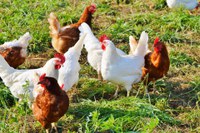Poultry Farmers Encouraged to Protect their Flock from HPAI
(Click the image below to view a high-resolution image that can be downloaded)
Highly Pathogenic Avian Influenza (HPAI) is a disease that is carried by wild birds and affects domestic poultry. With more than 19 million birds in flight and spring migration currently underway, now is the time for poultry farmers to ramp up biosecurity efforts.
“A total of eight positive cases have been confirmed in South Dakota since March 6,” says Miranda Meehan, North Dakota State University (NDSU) Extension livestock environmental stewardship specialist. “The risk for more infected birds will increase as migratory birds start returning to the area.”
“HPAI does not pose a risk to the public, and there is no food safety concern for consumers,” says Meehan. “Poultry testing positive for HPAI are prohibited by law from entering the marketplace.”
One of the first clinical signs is sudden, unexplained death. Most HPAI cases are reporting a decline in water consumption up to 72 hours prior to the unexplained death. Decreased egg production and depression in layers may be another sign that birds are not feeling well. Purple or dry combs, being quieter than normal, frequent laying down and swelling around eyes are other symptoms birds may experience. Chickens and turkeys are most susceptible to HPAI while waterfowl such as geese and ducks carry the virus and spread it to other birds.
“The best defense against HPAI is having a biosecurity plan in place,” says Mary Keena, NDSU Extension livestock environmental management specialist. “It is your job as a flock owner to create a line of separation between your clean flock and the potential unclean issues that wildlife or visitors may bring.”
The biosecurity practices to consider implementing if you have domesticated birds are:
- Reduce the attractiveness for wild birds to stop at your place by cleaning up litter and spilled feed around poultry housing areas.
- If you have free range guinea fowl and waterfowl, consider bringing them into coops or flight pens under nets to prevent interaction of domesticated poultry with wild birds and their droppings.
- Non-lethal methods to deter wild bird are available on the U.S. Department of Agriculture (USDA) Wildlife Damage webpage: https://www.aphis.usda.gov/aphis/ourfocus/wildlifedamage/sa_reports/ct_wildlife+damage+management+technical+series.
- Small songbirds are low risk for spreading the disease.
- Do not walk through or drive trucks, tractors or equipment through areas where waterfowl or other wildlife feces may be. If you cannot avoid this, clean your shoes, vehicles and equipment thoroughly to prevent transferring disease to your flock.
- If visitors will be interacting with your birds, make sure you know where they have been, require them to wash their hands and ensure their clothes and footwear are clean and disinfected.
- Think carefully before visiting swaps, fairs and exhibitions where birds are co-mingled, shown or sold. If you go, take extra precautions before returning home to your flock. Shower, change clothes, and clean and disinfect footwear before returning to your poultry housing areas.
If you would like to receive updates on the status of HPAI in your area, please complete the voluntary North Dakota Poultry Survey at https://bit.ly/3IvXLhj.
More information about biosecurity can be found on the USDA Defend the Flock Resource Center webpage: https://www.aphis.usda.gov/aphis/ourfocus/animalhealth/animal-disease-information/avian/defend-the-flock-program.
Report sick birds to your local veterinarian. If you do not have a local veterinarian for your flock, contact the North Dakota State Veterinarian’s office at 701-328-2655.
NDSU Agriculture Communication – March 24, 2022
Source: Miranda Meehan, 701-231-7683, miranda.meehan@ndsu.edu
Source: Mary Keena, 701-652-2951, mary.keena@ndsu.edu
Editor: Kristin Harner, 701-231-7875, kristin.harner@ndsu.edu


